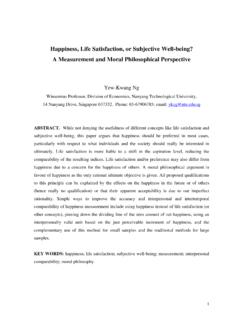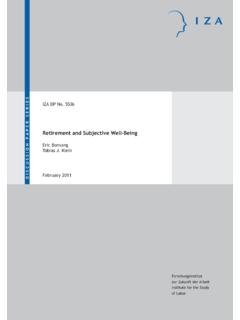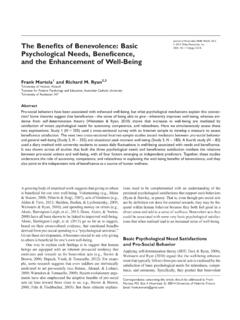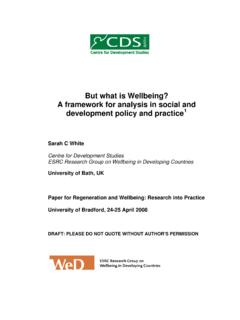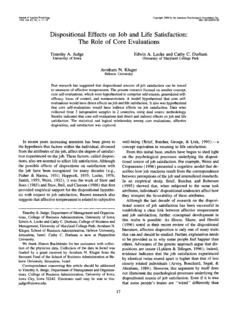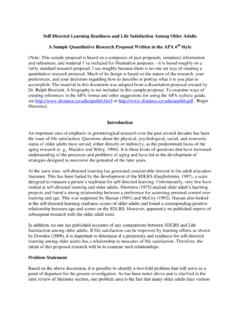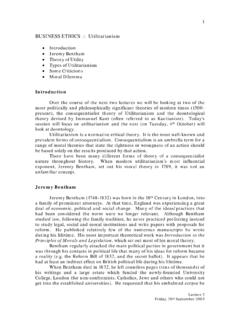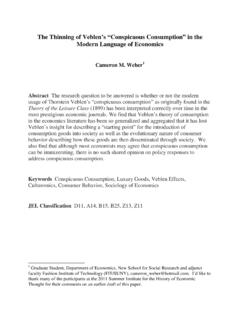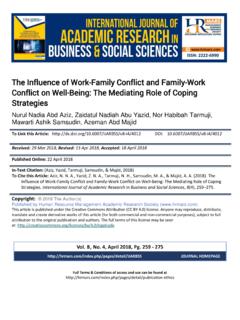Transcription of The Relative Income Hypothesis
1 The Relative Income Hypothesis Francisco Alvarez-Cuadrado Department of Economics, McGill University, Montreal H3A 2T7, Canada and Ngo Van Long Department of Economics, McGill University, Montreal H3A 2T7, Canada This Version: 6 March 2009. Abstract Despite its theoretical dominance, the empirical case in favor of the permanent Income Hypothesis is at best a weak one. Contrary to one of its basic implications, a growing body of evidence suggests that rich households save a higher propor- tion of their permanent Income than poor households. Following Duesenberry (1949), we propose an overlapping generations economy where households care about Relative consumption, the di erence between their consumption and the consumption of their reference group.
2 As a result, an individual's consumption is driven by the comparison of his lifetime Income and the lifetime Income of his reference group; a permanent Income version of the Duesenberry's (1949) rela- tive Income Hypothesis . Across households the savings rate increases with Income while aggregate savings are independent of the Income distribution. Positional concerns lead agents to over-consume, over-work, and under-save, Relative to the welfare maximizing levels that a planner would choose. We propose a simple tax schedule that induces the competitive economy to achieve allocative e ciency.
3 JEL Classi cation: D62, E21, H21. Key words: Relative consumption; Relative Income Hypothesis ; permanent Income hy- pothesis. 1. 1 Introduction James Duesenberry, in his seminal work, Income , Saving and the Theory of Consumer Behavior (1949), introduces the Relative Income Hypothesis in an attempt to rationalize the well established di erences between cross-sectional and time-series properties of consumption data. On the one hand, a wealth of studies based on 1935-36 and 1941-42 cross-sectional budget surveys present a saving ratio that increased with Income . On the other hand, the data on aggregate savings and Income from 1869 to 1929 collected by Kuznets (1942) presents a trend-less saving ratio.
4 Duesenberry (1949) proposes an individual consumption function that depends on the current Income of other people. As a result "for any given Relative Income distribution, the percentage of Income saved by a family will tend to be a unique, invariant, and increasing function of its percentile position in the Income distribution. The percentage saved will be independent of the absolute level of Income . It follows that the aggregate saving ratio will be independent of the absolute level of Income " (Duesenberry, 1949, pg. 3). Despite its empirical success, the Relative Income Hypothesis was quickly replaced by the well- known permanent Income Hypothesis (Modigliani and Brumberg (1954), Friedman (1957)).
5 As the economists'workhorse to understand consumption behavior. According to this view the cross-sectional correlation between saving and Income is driven by transitory deviations from permanent Income , while in the aggregate, most transitory components cancel out, leading to the close relation between consumption and Income observed in time series data. This paper presents a fully speci ed model of intertemporal choice that formalizes Due- senberry's intuitions. We consider an overlapping generations economy where households di er in the initial bequest they inherit from their parents.
6 Households derive utility from leisure, bequest and the di erence between their consumption and the consumption of others, Relative consumption. In this context, the resulting consumption of an agent is driven by the comparison of his lifetime Income and the lifetime Income of his reference group; a permanent Income version of the Relative Income Hypothesis . As in Duesenberry (1949), in- dividual saving rates increase with Relative Income while aggregate savings are independent of the Income distribution. Positional concerns lead agents to consume and work above the welfare maximizing levels that a benevolent central planner would choose.
7 We propose a simple tax schedule that induces the competitive economy to achieve the e cient allocation. Along the lines anticipated by Frank (2007) it consists on a progressive tax on consumption. Despite its overwhelming theoretical dominance, the empirical case in favor of the per- manent Income Hypothesis is at best a weak one. Much of the early empirical work (Brady and Friedman (1947) and Mayer (1966)) presents strong evidence against the proportion- 2. ality of savings rates. Recent empirical work has only con rmed these ndings. Browning and Lusardi (1996) conclude that the observed positive relationship between Income and saving is di cult to rationalize in terms of consumption smoothing.
8 Dynan, et al. (2004). use panel data to instrument permanent Income by education, lagged and future earnings, and measures of consumption. Their careful analysis nds a strong positive relationship between saving rates and lifetime Income . The literature on inter-generational saving, be- quests and inter-vivos transfers, nds similar results. In recent work, Altonji and Villanueva (2007) estimate that, at the mean of permanent earnings, parents pass on about cents of every extra dollar of lifetime resources to their children through bequests. Furthermore, their estimate increases with Income , demonstrating that wealthier households bequeath a larger proportion of their Income than poor households do.
9 If we are to believe this recent body of evidence we need to depart from the standard version of the permanent Income hypothesis1 . Our model does so in an intuitive way, abandoning the independent preference assumption that underlies Friedman's analysis. The resulting behavior, a mixture of per- manent and Relative Income components, preserves the basic implications of the permanent Income Hypothesis while being consistent with the empirical evidence on the cross-section of saving out of permanent Income . The assumption that preferences are independent across households, although standard in the economic literature, is not particularly appealing.
10 Indeed, social scientists have long stressed the relevance of status seeking as being an important characteristic of human be- havior (see Schoeck (1966) and Rawls (1971)). The idea that the overall level of satisfaction derived from a given level of consumption depends, not only on the consumption level itself, but also on how it compares to the consumption of other members of society, is not new in economics. Though origins of this proposition can be traced as far back as Smith (1759). and Veblen (1899), it was not until the work of Duesenberry (1949) and Pollak (1976) that an e ort was made to provide this idea with some micro-theoretic foundations.

